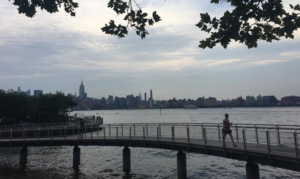
Hoboken Police Chief Addresses Waterfront Safety Concerns After Spate of High-Profile Incidents
Last Wednesday, an individual who had been reported missing was recovered in the water off Pier A in Hoboken. His was the second body recovered in that part of the Hudson River that week.
Bodies tend to surface in these waters with alarming frequency, prompting genuine concerns and speculative comments on the circumstances in which these individuals end up entering the Hudson. In Hoboken, a number of incidents in recent years have brought about a demand for cameras along the Waterfront and evoked unease over possible connections that tie the incidents together.
Prompted by ongoing social media conversations in Hoboken online forums, Hoboken Police Chief Kenneth Ferrante issued a statement on those forums—also sending it along for us to share.
Over the past 8 years, all of the events with individuals going into the Hudson River (NOT including last week’s Baltimore Resident’s death) appear to have been voluntary entries into the water. We have had approximately 15-20 in the that time. None of them have been determined to be homicides and none of them have any evidence that supports that. Some people like to post a 2014 Hoboken Patch article from Leprecon, where an individual claims to have been thrown into the water. Within a few hours of that event, it was determined that male was falsely reporting the facts of that night to police,” said Ferrante. “I do not know why that information was never followed up and released to the public but that was right before I became Chief so I had no control over that. Every time we have the unfortunate situation of someone going into the river, people point to that false story and account.”
The LepreCon story has been a key component to theories that there was something sinister occurring on the waterfront, and this is the first time we here at hMAG have heard it officially refuted. The “Smiley Face Killer” theory—which maintains that a network of killers is operating across the Northeast and Midwest, targeting males in their mid 20’s after a night out—has been mentioned in the aftermath of recent suspicious events along the waterfront. There have also been other incidents in which revelers have willingly jumped into the Hudson—often ending in tragedy.

“Due to many individuals voluntarily entering the river, I created a Waterfront and Parks Unit on January 1st, 2015 and we have had saves in the river of those who were observed entering. Before I became Chief, Water bags were added to all police cars in order to throw to individuals who are in distress in the river,” said Ferrante. “The reasons we have had individuals enter the waters are many: swimming, dares, intoxication or individuals under the influence of drugs, citizens trying to rescue others, hallucinating individuals jumping in to save babies that were really stuffed animals, and in quite a few of these cases—suicide.”
Often, in the immediate aftermath of a disappearance or a recovery, there’s a perceived media silence in regards to the case. Chief Ferrante explains why information is released when it is, and why it’s important for local media organizations to honor that.
 “The Hudson County Prosecutors Office handle all death investigations. Most times, they turn the case back over to us. In cases where the incident is deemed suicide, that is not put out to the public for several reasons; 1) sensitivity and confidentiality with the next of kin, 2) we cannot disclose mental illness publicly, 3) human decency to help the family deal with something tragic and life altering to them, which inquiring minds don’t take into account.”
“The Hudson County Prosecutors Office handle all death investigations. Most times, they turn the case back over to us. In cases where the incident is deemed suicide, that is not put out to the public for several reasons; 1) sensitivity and confidentiality with the next of kin, 2) we cannot disclose mental illness publicly, 3) human decency to help the family deal with something tragic and life altering to them, which inquiring minds don’t take into account.”
Basically, investigating organizations and media organizations need to maintain certain protocols. While it may seem like stonewalling to the reading public, these protocols are followed out of an abundance of respect for the family of the deceased, and to ensure the integrity of the investigation.
Yet in the absence of fact, speculation runs rampant. Social media has a tendency to fuel that speculation, as theories are exchanged and extrapolated upon. To that, Chief Ferrante said the following.
“I can assure you that there are no current threats to the public regarding the waterfront and there has not been over the past 8 years, and there is no ‘smiley face serial killers‘ throwing people in the river in Hoboken.”

Smiley faces found at kiosks in Pier A—January 2016.
Some might find that to be a bold statement by the Chief, given the volume of incidents in our region.
One such incident that still remains puzzling to many was the 2014 disappearance and eventual recovery of the body of 27-year old Hoboken bank employee Andrew Jarzyk, who reportedly went jogging in the early morning hours immediately after a night out at a bar with friends. Another high-profile drowning incident in Hoboken was the death of 24-year old finance worker Matthew Genovese. He reportedly went down to the river after a night at the bar with friends during a blizzard in 2016. His body was recovered days later. Meanwhile, Hoboken Police recovered the body of 23-year old college student Anthony Urena just days earlier, after he entered the river on the Manhattan side further upstream.

Smiley face painted on tree near railing on Pier A, January 2016.
As questions circulated about these incidents, hMAG met with Kevin Gannon—a retired NYPD detective and author who has worked diligently on the Smiley Face Killer cases. Gannon joined hMAG Publisher Christopher Halleron on a walking tour of Pier A in February of 2016 to look for any evidence in the aftermath of Genovese’s death. While Gannon remains suspicious that there may be a connection between incidents elsewhere, at the time he did not feel the urge to pursue any direct connection to the events in Hoboken.
Of course the only way to every be truly sure of that is to install cameras along the waterfront—an issue that has been a hot topic since before the disappearance of Jarzyk in 2014.
 “As far as cameras, they are not cheap. First, you would need on at least one every .1 mile of the 1.3 miles to possibly capture events there,” said Ferrante. “While a citizen can buy a camera and put up in their home for a couple hundred dollars, each government camera, due to needed reception to link to a secured server sometimes over a mile away, which is protected from hacking, and due to evidence laws and OPRA laws, needs retention time and space up to a year in some cases; ends up costing 10s of thousands EACH, and cameras don’t stop suicides.”
“As far as cameras, they are not cheap. First, you would need on at least one every .1 mile of the 1.3 miles to possibly capture events there,” said Ferrante. “While a citizen can buy a camera and put up in their home for a couple hundred dollars, each government camera, due to needed reception to link to a secured server sometimes over a mile away, which is protected from hacking, and due to evidence laws and OPRA laws, needs retention time and space up to a year in some cases; ends up costing 10s of thousands EACH, and cameras don’t stop suicides.”
Meanwhile, the investigation into the latest incident remains very much active.
“Regarding the Baltimore resident found in the Hudson River last week, I do not have the authority to answer any questions on that matter as it is still under Investigation by the Hudson County Prosecutors Office,” said Ferrante. “They update me on this almost daily. I cannot disclose that to the public and I only disclose info to our interested investigative parties so that the information does not leak out. I will assure you, at this time, there are no threats to the public waterfront and if at any time in the future, one does arise, I would immediately let the public know and increase our waterfront deployments.”
Ultimately, tragic incidents like these serve as a stark reminder that we all live in a big city, on the banks of a big river. It’s important to remember that on a night out, and to try and be as vigilant as possible.
***

 Previous Article
Previous Article Next Article
Next Article Hoboken Celebrates New Mural on Northern Edge, Celebrating Inspirational Women of the Mile Square City
Hoboken Celebrates New Mural on Northern Edge, Celebrating Inspirational Women of the Mile Square City  HEAVEN, HELL OR HOBOKEN: Hoboken Historical Museum Hosts Lecture Series for 100th Anniversary of America’s Entry into World War I
HEAVEN, HELL OR HOBOKEN: Hoboken Historical Museum Hosts Lecture Series for 100th Anniversary of America’s Entry into World War I  WALK SAFE HOBOKEN: Police Department Receives Grant for Pedestrian Safety Program
WALK SAFE HOBOKEN: Police Department Receives Grant for Pedestrian Safety Program  “KALEIDOSCOPE”: Mixed-Media Exhibit at hob’art gallery
“KALEIDOSCOPE”: Mixed-Media Exhibit at hob’art gallery  Why Pete Hamill Matters
Why Pete Hamill Matters  Fridays Are For Frank: “Ring-a-Ding-Ding!”
Fridays Are For Frank: “Ring-a-Ding-Ding!”  CHRISTMAS STOCKINGS: D’s Soul Full Cafe Hosts Charity Sock Drive and Holiday Celebration
CHRISTMAS STOCKINGS: D’s Soul Full Cafe Hosts Charity Sock Drive and Holiday Celebration  RECURRING DREAM: The Dream Syndicate on Hand to Celebrate 24 Years of the Hoboken Arts & Music Festival — Sunday, May 6th
RECURRING DREAM: The Dream Syndicate on Hand to Celebrate 24 Years of the Hoboken Arts & Music Festival — Sunday, May 6th